How farmers in Italy's quake-hit region have fought to save their harvests
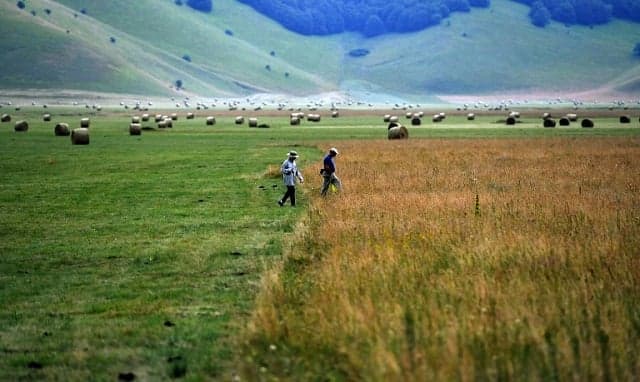
A combination of quake damage, inaccessible roads, and - above all - bureaucracy, put harvests in Italy's central region at risk this year. Lorenzo Holt speaks to local farmers about how they're fighting to save agriculture in the quake-hit region.
On April 3rd, a convoy of tractors and military vehicles carrying heavy farm equipment wound its way up the ountains of central Italy into the red zone – an area restricted to civilians after last year’s earthquakes.
The machinery was headed for the small Apennine village of Castelluccio where, across 525 hectares of high-altitude plains, local farmers would begin to sow over 50 tonnes of lentil seeds.
“Since man has lived in Castelluccio he has grown lentils there,” Gianni Coccia, spokesman for the local farmers and native of Castelluccio, said.
“I’ve farmed there my whole life. This year we were very close to skipping the harvest for the first time ever.”
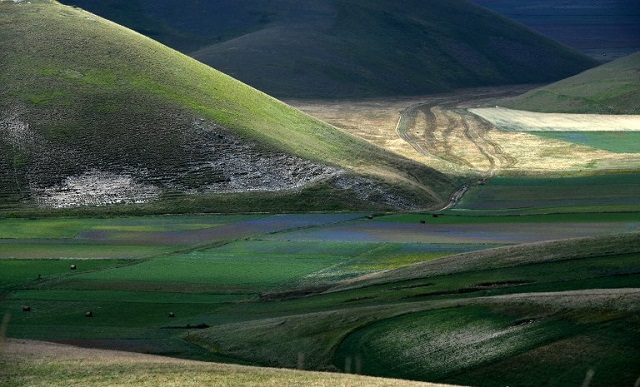
A panoramic view of the fields. Photo: Tiziana Fabi/AFP
READ ALSO: Italy's quake-hit towns are bidding for Unesco status
Accessing the Castelluccio's fields was difficult this year after an earthquake on October 30th emptied the village and shut down the 28 km route linking it to Norcia, the nearby town where most of the farmers live.
Heavy snowfall had hampered reconstruction during the winter and as spring approached the road remained inaccessible.
Concerned over the lack of progress, the farmers petitioned the government for permission to access the usual route. They were offered an impractical alternative: a 90 km detour along narrow mountain roads and traversing three regions.
 A young woman walks in the lentil fields. Photo: Tiziana Fabi/AFP
A young woman walks in the lentil fields. Photo: Tiziana Fabi/AFP
“It would have been a five hour trip on asphalt roads that would have ruined our tractors’ tires in four or five trips,” Coccia said. “Those tires can cost €12,000. It wasn’t feasible.”
The farmers began protesting on March 26th, spending nights outside with their tractors in the hopes of pressuring the government.
It worked. Three days later, the farmers were allowed to head to the fields with firefighters securing the road and an escort of military trucks carrying along their seeders, tracked tractors and other agricultural machinery.
For Coccia and the other farmers, the lentil fields are not only a livelihood but a way of maintaining their connection with the village they lost. Castelluccio is one of the few villages affected by the earthquakes where the residents have not been allowed to return to collect belongings, Coccia said.
“The land, the warmth, the memories as a child; all those have been buried. Where we used to play as children in the piazzas and the alleys, the little games that children play, the earthquake buried all those along with the town,” Coccia said. “But we still love it, and we want to rebuild it as soon as possible.”
READ ALSO: The farmers, their little pigs and the wolves: An Italy quake survival tale
Around 25 farmers work in Castelluccio now, from morning until night, but the progress is slow. There are no accessible buildings near them and if something breaks down it requires a long trip back to Norcia to get spare parts.
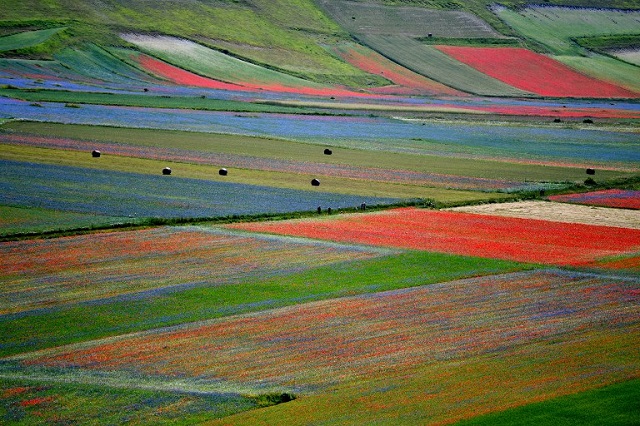
The lentil fields. Photo: Tiziana Fabi/AFP
“Now we’re on our own,” Coccia said. “We leave our tractors there overnight and come and go using the long route. So far we haven’t had any serious problems, just a broken tube or a leak.
"But if something happens with a motor or a tire then we’ve got a real problem. The military has gone so we’d have to hire private help, which would be very expensive.”
Despite the precariousness of their situation, Coccia is hopeful that barring inclement weather and serious equipment failure, the farmers can finish sowing by the end of the April – late, but not too late.
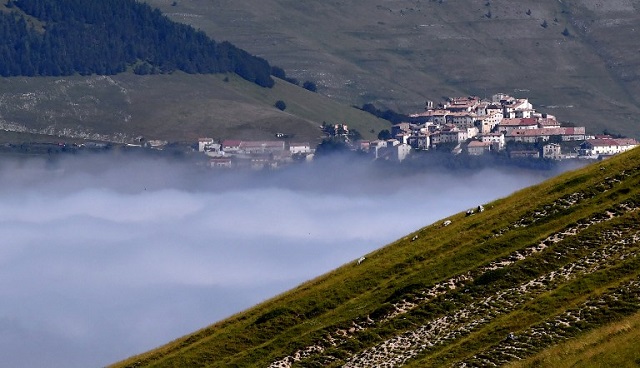
Castelluccio. Photo: Tiziana Fabi/AFP
A good harvest can yield up to 4,000 tonnes of lentils, which have a retail value of around €12 per kilo. The lentils grown on the plains of Castelluccio are packaged with Protected Geographical Indication (IGP) seals, which guarantee their unique origin and command a higher price.
However, the importance of the lentils extends beyond their fine qualities as legumes. They are also responsible for a mid-summer event that the locals call “La Fiorita”, when, around June each year, thousands of flowers bloom slowly over a month, bathing the lentil fields in shifting shades of red, blue and yellow.
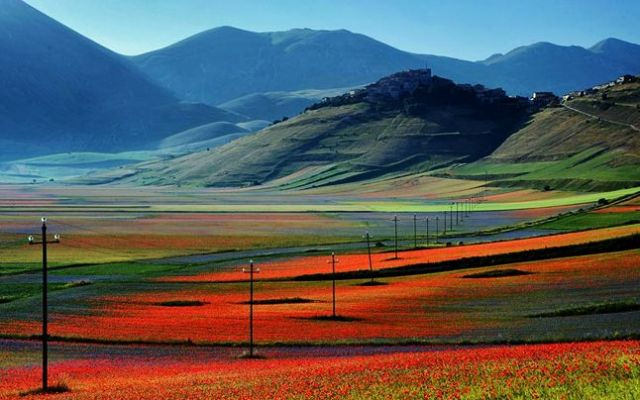
Photo: Viaggio Routard/Flickr
“Thousands and thousands of tourists come to see the bloom,” Giuseppina Perla, Norcia’s Counselor of Culture, said. “We’re working with the province and [highways agency] ANAS to open the roads and secure some buildings in time for it. It’s a priority.”
Fiorita aside, opening the roads again in time for the September harvest is essential for the farmers, who will need to bring even larger machines to and from the fields.
By Lorenzo Holt.
Lorenzo Holt is a freelance journalist based in Sicily. Contact Lorenzo on Twitter.
NOW READ: After the earthquakes, why you should still visit central Italy
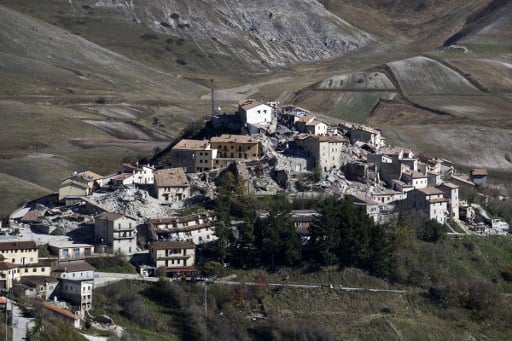
Comments
See Also
On April 3rd, a convoy of tractors and military vehicles carrying heavy farm equipment wound its way up the ountains of central Italy into the red zone – an area restricted to civilians after last year’s earthquakes.
The machinery was headed for the small Apennine village of Castelluccio where, across 525 hectares of high-altitude plains, local farmers would begin to sow over 50 tonnes of lentil seeds.
“Since man has lived in Castelluccio he has grown lentils there,” Gianni Coccia, spokesman for the local farmers and native of Castelluccio, said.
“I’ve farmed there my whole life. This year we were very close to skipping the harvest for the first time ever.”

A panoramic view of the fields. Photo: Tiziana Fabi/AFP
READ ALSO: Italy's quake-hit towns are bidding for Unesco status
Accessing the Castelluccio's fields was difficult this year after an earthquake on October 30th emptied the village and shut down the 28 km route linking it to Norcia, the nearby town where most of the farmers live.
Heavy snowfall had hampered reconstruction during the winter and as spring approached the road remained inaccessible.
Concerned over the lack of progress, the farmers petitioned the government for permission to access the usual route. They were offered an impractical alternative: a 90 km detour along narrow mountain roads and traversing three regions.
 A young woman walks in the lentil fields. Photo: Tiziana Fabi/AFP
A young woman walks in the lentil fields. Photo: Tiziana Fabi/AFP
“It would have been a five hour trip on asphalt roads that would have ruined our tractors’ tires in four or five trips,” Coccia said. “Those tires can cost €12,000. It wasn’t feasible.”
The farmers began protesting on March 26th, spending nights outside with their tractors in the hopes of pressuring the government.
It worked. Three days later, the farmers were allowed to head to the fields with firefighters securing the road and an escort of military trucks carrying along their seeders, tracked tractors and other agricultural machinery.
For Coccia and the other farmers, the lentil fields are not only a livelihood but a way of maintaining their connection with the village they lost. Castelluccio is one of the few villages affected by the earthquakes where the residents have not been allowed to return to collect belongings, Coccia said.
“The land, the warmth, the memories as a child; all those have been buried. Where we used to play as children in the piazzas and the alleys, the little games that children play, the earthquake buried all those along with the town,” Coccia said. “But we still love it, and we want to rebuild it as soon as possible.”
READ ALSO: The farmers, their little pigs and the wolves: An Italy quake survival tale
Around 25 farmers work in Castelluccio now, from morning until night, but the progress is slow. There are no accessible buildings near them and if something breaks down it requires a long trip back to Norcia to get spare parts.

The lentil fields. Photo: Tiziana Fabi/AFP
“Now we’re on our own,” Coccia said. “We leave our tractors there overnight and come and go using the long route. So far we haven’t had any serious problems, just a broken tube or a leak.
"But if something happens with a motor or a tire then we’ve got a real problem. The military has gone so we’d have to hire private help, which would be very expensive.”
Despite the precariousness of their situation, Coccia is hopeful that barring inclement weather and serious equipment failure, the farmers can finish sowing by the end of the April – late, but not too late.

Castelluccio. Photo: Tiziana Fabi/AFP
A good harvest can yield up to 4,000 tonnes of lentils, which have a retail value of around €12 per kilo. The lentils grown on the plains of Castelluccio are packaged with Protected Geographical Indication (IGP) seals, which guarantee their unique origin and command a higher price.
However, the importance of the lentils extends beyond their fine qualities as legumes. They are also responsible for a mid-summer event that the locals call “La Fiorita”, when, around June each year, thousands of flowers bloom slowly over a month, bathing the lentil fields in shifting shades of red, blue and yellow.

Photo: Viaggio Routard/Flickr
“Thousands and thousands of tourists come to see the bloom,” Giuseppina Perla, Norcia’s Counselor of Culture, said. “We’re working with the province and [highways agency] ANAS to open the roads and secure some buildings in time for it. It’s a priority.”
Fiorita aside, opening the roads again in time for the September harvest is essential for the farmers, who will need to bring even larger machines to and from the fields.
By Lorenzo Holt.
Lorenzo Holt is a freelance journalist based in Sicily. Contact Lorenzo on Twitter.
NOW READ: After the earthquakes, why you should still visit central Italy

Join the conversation in our comments section below. Share your own views and experience and if you have a question or suggestion for our journalists then email us at [email protected].
Please keep comments civil, constructive and on topic – and make sure to read our terms of use before getting involved.
Please log in here to leave a comment.